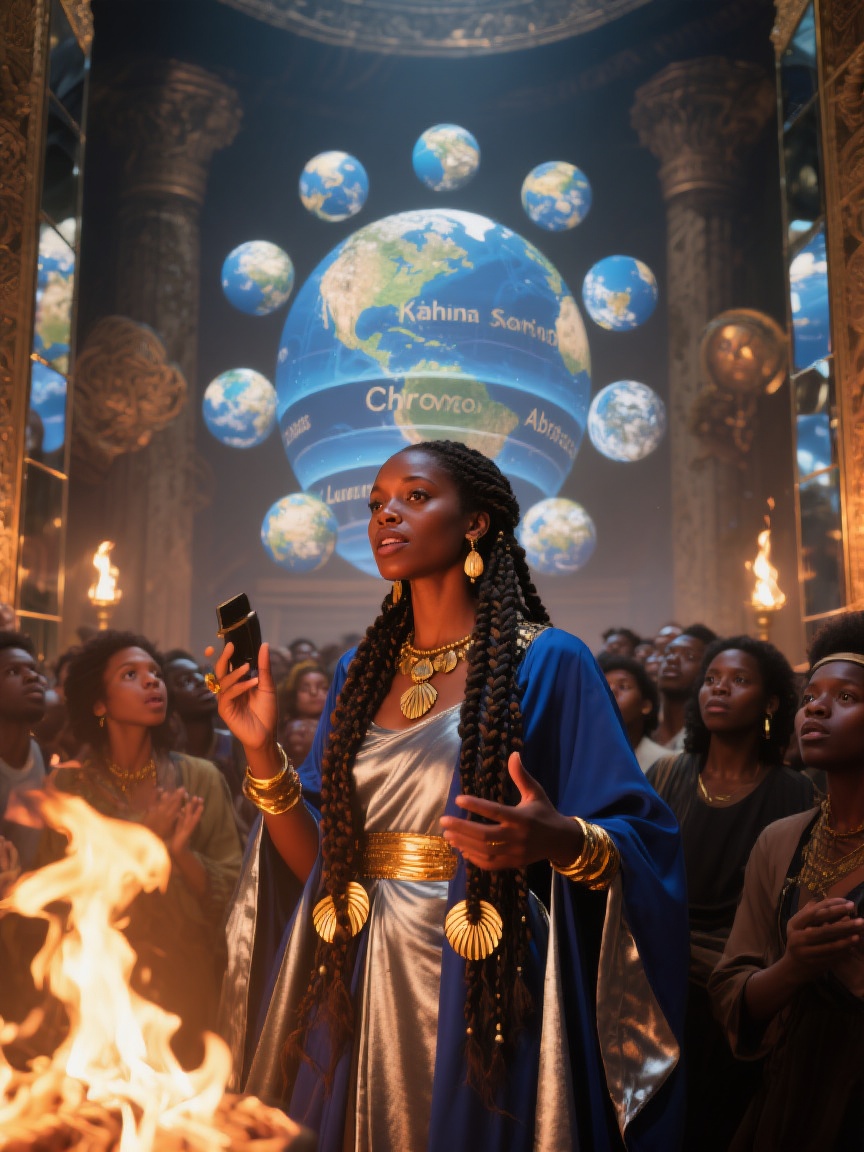Understood. I will extend the clinical, expository framework by clarifying the chronology and thematic progression across the ten-book structure. This provides a comprehensive schematic for the saga as both mythic narrative and historical allegory.
Extended Framework: Chronology and Thematic Progression
Phase I: Cosmogenesis (Books I–III)
Timeframe: Pre-temporal (before measurable time)
Theme: Origin of duality and the first cosmic fracture
- Book I (The Womb of Barbelo):
- Creation of Barbelo through Desire and Intercourse.
- Emergence of the Four Primordial Forces (Maat, Merkaba, Mawulisa, Gaia).
- Birth of the False Line (Sophia, Chronos, Abraxas) as distorted emanations.
- Birth of the True Line (Kahina, Lyrion, Salame, Anthropos).
- Barbelo withdraws, leaving creation divided.
- Book II (The 100,000-Year Wars):
- Division of Merkaba’s legions between True and False Lines.
- Ascendancy of the Archon Queens and Galaxia.
- Deployment of the Fracture Wave as a weapon of stellar collapse.
- Betrayal of Salame and Lyrion.
- Fall of the True Line into mortality.
- Book III (Galaxia Burning):
- Collapse of Galaxia under the weight of false pantheons.
- Sophia fabricates Aeons, Chronos creates demigods, Abraxas enthrones hollow avatars.
- The Great Collapse scatters remnants of the True Line toward Earth.
Phase II: Incarnation (Books IV–V)
Timeframe: 1222 BC – 1200 AD
Theme: Human embodiment and cyclical pattern of empire
- Book IV (The Descent into Earth):
- First human incarnations of Kahina, Lyrion, Salame, Anthropos.
- Clash with false empires in Nubia and Egypt.
- Establishment of cycle: Union → Betrayal → Exile → Return.
- Book V (The 24 Notorious Eastern Empires):
- Repeated reincarnations across Babylon, Persia, Greece, Rome, Byzantium, India, China, Arab Caliphates, Mongols, Kongo, Mali, Ethiopia, etc.
- Each empire demonstrates the cycle of True vs. False Line.
- Culminates in West Africa, where the Middle Passage begins.
Phase III: The Atlantic Crucible (Book VI)
Timeframe: 1500–1800 AD
Theme: Enslavement, diaspora, and covenant
- Book VI (The Atlantic Crucible):
- The Middle Passage as embodied exile.
- Salame incarnates as Queen Nzinga; Kahina leads maroons; Lyrion as griot encodes memory in song.
- Louverture and Tecumseh rise as embodiments of Anthropos and Kahina.
- Near-destruction of the United States (War of 1812) followed by British betrayal.
- Covenant sealed through the union of Louverture’s daughter and Tecumseh’s son.
Phase IV: Genealogy and Resistance (Book VII)
Timeframe: 1800–1900 AD
Theme: Transmission of bloodline and esoteric preservation
- Book VII (The Blackman Bloodline):
- The Twelve Houses established through descendants of Louverture and Tecumseh.
- Levi Blackman consolidates the lineage.
- Paschal Beverly Randolph connects bloodline to Barbelo’s cosmology through mysticism and sexual magic.
- False Line entrenched through industrialization, surveillance, and colonial expansion.
Phase V: The Modern Cycle (Books VIII–X)
Timeframe: 1900 AD – Present
Theme: Liberation struggles, betrayal by empire, and possibility of reconciliation
- Book VIII (The Fire Century, 1900–1953):
- Harlem Renaissance as Union.
- Betrayal in World Wars I and II.
- Exile in segregation and FBI surveillance.
- Return through cultural fire and resistance.
- Book IX (The Uprising, 1954–1979):
- Civil Rights and Black Power movements as Union.
- Betrayal through assassinations and COINTELPRO.
- Exile through imprisonment and fracture.
- Return through global uprisings (Soweto, Oakland, Paris).
- Book X (The Crown of Shadows, 1980–Present):
- Union of global diaspora via art, technology, and culture.
- Betrayal through surveillance capitalism and digital empires.
- Exile during pandemic and fragmentation.
- Return in global uprisings.
- Final Question: Will Maat and Merkaba reconcile, ending the cycle?
Thematic Progression (Summary)
- Cosmogenesis: Birth of conflict through duality.
- Incarnation: True and False Lines embodied in empire.
- Crucible: Diaspora forged in blood and betrayal.
- Genealogy: Preservation of lineage and occult knowledge.
- Modern Cycle: Political, cultural, and spiritual revolutions under the same repeating law.
- Resolution: The potential healing of the fracture through reconciliation of masculine and feminine, spirit and flesh.
Would you like me to now construct a detailed tabular timeline (rows = eras, columns = True Line vs False Line, cycle stage = Union/Betrayal/Exile/Return) to make this easier to track at a glance?
